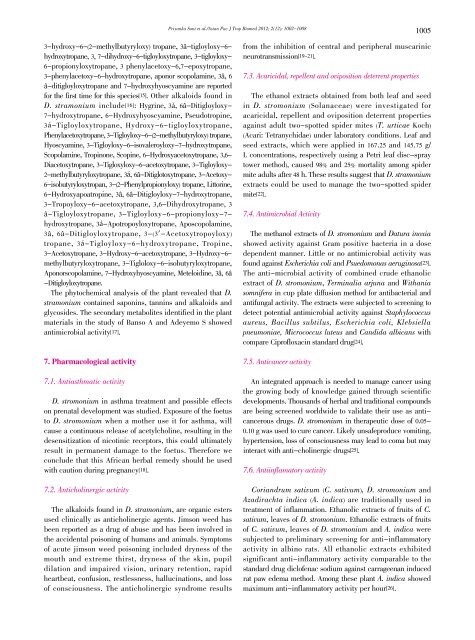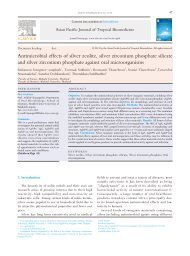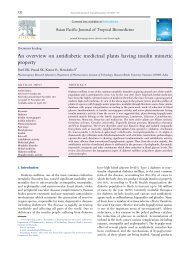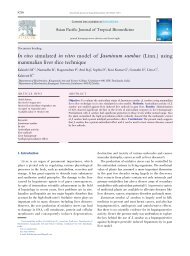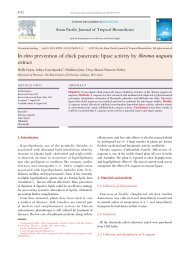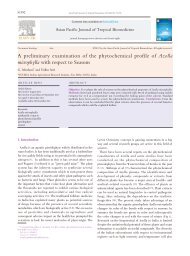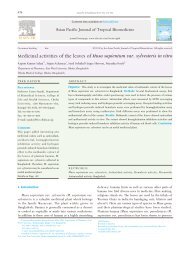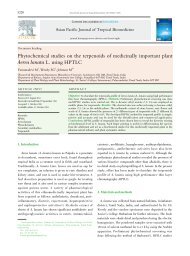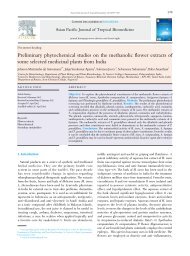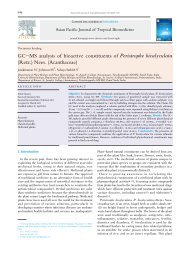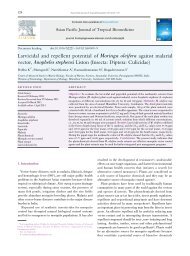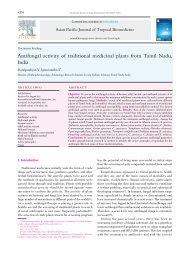Pharmacological properties of Datura stramonium L. as a - Apjtb.com
Pharmacological properties of Datura stramonium L. as a - Apjtb.com
Pharmacological properties of Datura stramonium L. as a - Apjtb.com
Create successful ePaper yourself
Turn your PDF publications into a flip-book with our unique Google optimized e-Paper software.
3-hydroxy-6-(2-methylbutyryloxy) tropane, 3覾-tigloyloxy-6hydroxytropane,<br />
3, 7-dihydroxy-6-tigloyloxytropane, 3-tigloyloxy-<br />
6-propionyloxytropane, 3 phenylacetoxy-6,7-epoxytropane,<br />
3-phenylacetoxy-6-hydroxytropane, aponor scopolamine, 3覾, 6<br />
覾-ditigloyloxytropane and 7-hydroxyhyoscyamine are reported<br />
for the first time for this species[15]. Other alkaloids found in<br />
D. <strong>stramonium</strong> include[16]: Hygrine, 3á, 6覾-Ditigloyloxy-<br />
7-hydroxytropane, 6-Hydroxyhyoscyamine, Pseudotropine,<br />
3á-Tigloyloxytropane, Hydroxy-6-tigloyloxytropane,<br />
Phenylacetoxytropane, 3-Tigloyloxy-6-(2-methylbutyryloxy) tropane,<br />
Hyoscyamine, 3-Tigloyloxy-6-isovaleroyloxy-7-hydroxytropane,<br />
Scopolamine, Tropinone, Scopine, 6-Hydroxyacetoxytropane, 3,6-<br />
Diacetoxytropane, 3-Tigloxyloxy-6-acetoxytropane, 3-Tigloyloxy-<br />
2-methylbutyryloxytropane, 3á, 6覾-Ditiglotoxytropane, 3-Acetoxy-<br />
6-isobutyryloxytropan, 3-(2-Phenylpropionyloxy) tropane, Littorine,<br />
6-Hydroxyapoatropine, 3覾, 6覾-Ditigloyloxy-7-hydroxytropane,<br />
3-Tropoyloxy-6-acetoxytropane, 3,6-Dihydroxytropane, 3<br />
覾-Tigloyloxytropane, 3-Tigloyloxy-6-propionyloxy-7-<br />
hydroxytropane, 3á-Apotropoyloxytropane, Aposcopolamine,<br />
3覾, 6覾-Ditigloyloxytropane, 3-(3’-Acetoxytropoyloxy)<br />
tropane, 3á-Tigloyloxy-6-hydroxytropane, Tropine,<br />
3-Acetoxytropane, 3-Hydroxy-6-acetoxytropane, 3-Hydroxy-6methylbutyryloxytropane,<br />
3-Tigloloxy-6-isobutyryloxytropane,<br />
Aponorscopolamine, 7-Hydroxyhyoscyamine, Meteloidine, 3覾, 6覾<br />
-Ditigloyloxytropane.<br />
The phytochemical analysis <strong>of</strong> the plant revealed that D.<br />
<strong>stramonium</strong> contained saponins, tannins and alkaloids and<br />
glycosides. The secondary metabolites identified in the plant<br />
materials in the study <strong>of</strong> Banso A and Adeyemo S showed<br />
antimicrobial activity[17].<br />
7. <strong>Pharmacological</strong> activity<br />
7.1. Anti<strong>as</strong>thmatic activity<br />
D. stromonium in <strong>as</strong>thma treatment and possible effects<br />
on prenatal development w<strong>as</strong> studied. Exposure <strong>of</strong> the foetus<br />
to D. stromonium when a mother use it for <strong>as</strong>thma, will<br />
cause a continuous rele<strong>as</strong>e <strong>of</strong> acetylcholine, resulting in the<br />
desensitization <strong>of</strong> nicotinic receptors, this could ultimately<br />
result in permanent damage to the foetus. Therefore we<br />
conclude that this African herbal remedy should be used<br />
with caution during pregnancy[18].<br />
7.2. Anticholinergic activity<br />
The alkaloids found in D. <strong>stramonium</strong>, are organic esters<br />
used clinically <strong>as</strong> anticholinergic agents. Jimson weed h<strong>as</strong><br />
been reported <strong>as</strong> a drug <strong>of</strong> abuse and h<strong>as</strong> been involved in<br />
the accidental poisoning <strong>of</strong> humans and animals. Symptoms<br />
<strong>of</strong> acute jimson weed poisoning included dryness <strong>of</strong> the<br />
mouth and extreme thirst, dryness <strong>of</strong> the skin, pupil<br />
dilation and impaired vision, urinary retention, rapid<br />
heartbeat, confusion, restlessness, hallucinations, and loss<br />
<strong>of</strong> consciousness. The anticholinergic syndrome results<br />
Priyanka Soni et al./Asian Pac J Trop Biomed 2012; 2(12): 1002-1008 1005<br />
from the inhibition <strong>of</strong> central and peripheral muscarinic<br />
neurotransmission[19-21].<br />
7.3. Acaricidal, repellent and oviposition deterrent <strong>properties</strong><br />
The ethanol extracts obtained from both leaf and seed<br />
in D. stromonium (Solanaceae) were investigated for<br />
acaricidal, repellent and oviposition deterrent <strong>properties</strong><br />
against adult two-spotted spider mites (T. urticae Koch)<br />
(Acari: Tetranychidae) under laboratory conditions. Leaf and<br />
seed extracts, which were applied in 167.25 and 145.75 g/<br />
L concentrations, respectively (using a Petri leaf disc-spray<br />
tower method), caused 98% and 25% mortality among spider<br />
mite adults after 48 h. These results suggest that D. <strong>stramonium</strong><br />
extracts could be used to manage the two-spotted spider<br />
mite[22].<br />
7.4. Antimicrobial Activity<br />
The methanol extracts <strong>of</strong> D. stromonium and <strong>Datura</strong> inoxia<br />
showed activity against Gram positive bacteria in a dose<br />
dependent manner. Little or no antimicrobial activity w<strong>as</strong><br />
found against Escherichia coli and Psuedomon<strong>as</strong> aeruginosa[23].<br />
The anti-microbial activity <strong>of</strong> <strong>com</strong>bined crude ethanolic<br />
extract <strong>of</strong> D. stromonium, Terminalia arjuna and Withania<br />
somnifera in cup plate diffusion method for antibacterial and<br />
antifungal activity. The extracts were subjected to screening to<br />
detect potential antimicrobial activity against Staphylococcus<br />
aureus, Bacillus subtilus, Escherichia coli, Klebsiella<br />
pneumoniae, Micrococcus luteus and Candida albicans with<br />
<strong>com</strong>pare Cipr<strong>of</strong>loxacin standard drug[24].<br />
7.5. Anticancer activity<br />
An integrated approach is needed to manage cancer using<br />
the growing body <strong>of</strong> knowledge gained through scientific<br />
developments. Thousands <strong>of</strong> herbal and traditional <strong>com</strong>pounds<br />
are being screened worldwide to validate their use <strong>as</strong> anticancerous<br />
drugs. D. stromonium in therapeutic dose <strong>of</strong> 0.05-<br />
0.10 g w<strong>as</strong> used to cure cancer. Likely unsafeproduce vomiting,<br />
hypertension, loss <strong>of</strong> consciousness may lead to <strong>com</strong>a but may<br />
interact with anti-cholinergic drugs[25].<br />
7.6. Antiinflamatory activity<br />
Coriandrum sativum (C. sativum), D. stromonium and<br />
Azadirachta indica (A. indica) are traditionally used in<br />
treatment <strong>of</strong> inflammation. Ethanolic extracts <strong>of</strong> fruits <strong>of</strong> C.<br />
sativum, leaves <strong>of</strong> D. stromonium. Ethanolic extracts <strong>of</strong> fruits<br />
<strong>of</strong> C. sativum, leaves <strong>of</strong> D. stromonium and A. indica were<br />
subjected to preliminary screening for anti-inflammatory<br />
activity in albino rats. All ethanolic extracts exhibited<br />
significant anti-inflammatory activity <strong>com</strong>parable to the<br />
standard drug dicl<strong>of</strong>enac sodium against carrageenan induced<br />
rat paw edema method. Among these plant A. indica showed<br />
maximum anti-inflammatory activity per hour[26].


